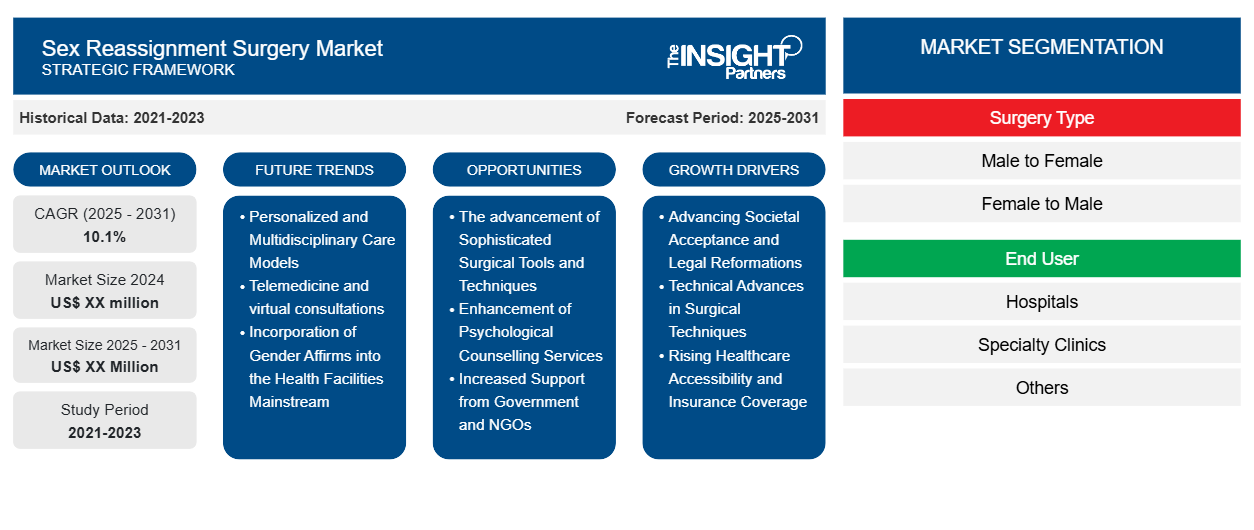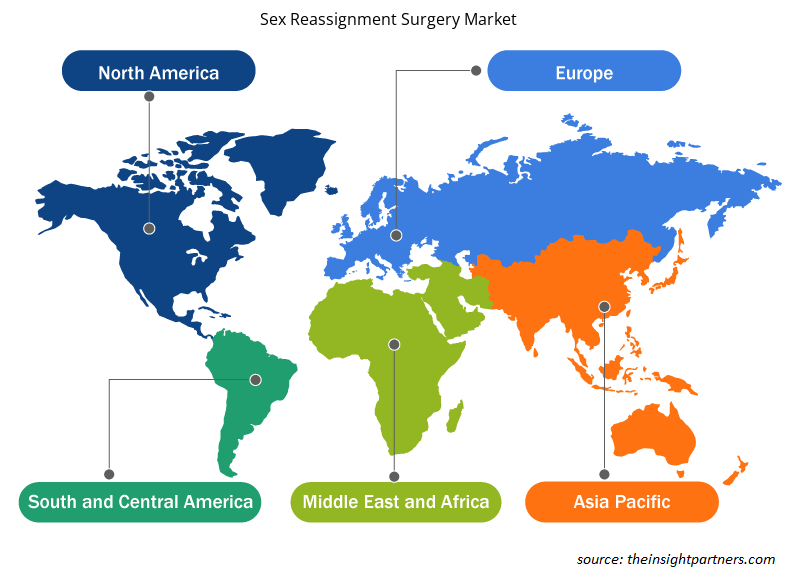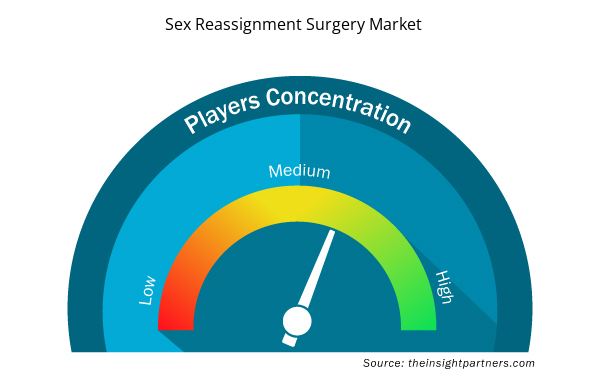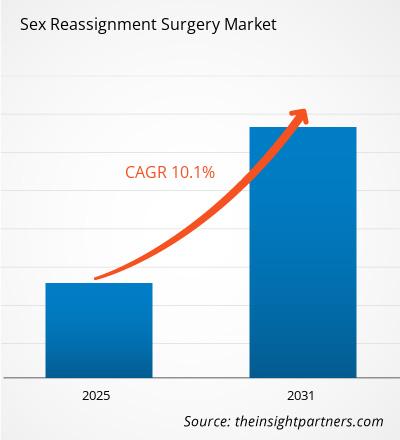The Sex Reassignment Surgery Market is expected to register a CAGR of 10.1% from 2025 to 2031, with a market size expanding from US$ XX million in 2024 to US$ XX Million by 2031.
The report is segmented by Surgery Type [Male to Female (Feminizing Vaginoplasty, Augmentation Mammoplasty, Facial Feminization Procedures, and Other Surgical Procedures) and Female to Male (Phalloplasty, Hysterectomy, and Other Surgical Procedures)]. The report is segmented by End User (Hospitals, Specialty Clinics, and Others). The global analysis is further broken-down at regional level and major countries. The Report Offers the Value in USD for the above analysis and segments.
Purpose of the Report
The report Sex Reassignment Surgery Market by The Insight Partners aims to describe the present landscape and future growth, top driving factors, challenges, and opportunities. This will provide insights to various business stakeholders, such as:
- Technology Providers/Manufacturers: To understand the evolving market dynamics and know the potential growth opportunities, enabling them to make informed strategic decisions.
- Investors: To conduct a comprehensive trend analysis regarding the market growth rate, market financial projections, and opportunities that exist across the value chain.
- Regulatory bodies: To regulate policies and police activities in the market with the aim of minimizing abuse, preserving investor trust and confidence, and upholding the integrity and stability of the market.
Sex Reassignment Surgery Market Segmentation
Surgery Type
- Male to Female
- Female to Male
End User
- Hospitals
- Specialty Clinics
- Others
You will get customization on any report - free of charge - including parts of this report, or country-level analysis, Excel Data pack, as well as avail great offers and discounts for start-ups & universities
Sex Reassignment Surgery Market: Strategic Insights

- Get Top Key Market Trends of this report.This FREE sample will include data analysis, ranging from market trends to estimates and forecasts.
Sex Reassignment Surgery Market Growth Drivers
- Advancing Societal Acceptance and Legal Reformations: The growing demand for sex reassignment surgeries is widening with significant social acceptability within the LGBTQ+ community. It progressively encouraged public expression of gender identity in many countries across continents, given that they are becoming more accepting of transgender people. Social conscience now mostly encourages many individuals to go for the surgeries as part of their transition. Most governments around the world have reached various stages of legal reforms concerning transgender rights, including complementary laws on non-discrimination and access to gender-affirming healthcare. Gender identity legalizations have mostly contributed to the greater accessibility and affordability of SRS procedures.
- Technical Advances in Surgical Techniques: Advances in technology related to the surgery have brought very good improvements in the outcome of operations concerning sex and greatly improved accessibility and efficiency. Improvements in minimally invasive techniques and advanced imaging have made great strides in surgical precision, reduced recovery time associated with surgery while minimizing complications. These technological advancements will continue to enhance good results from surgery, improve patient satisfaction, and produce success for the surgery in the long run. It is expected that with the innovations happening at breakneck speed with new surgical techniques, more people will seek out these services-tending to create stronger growth in this market.
- Rising Healthcare Accessibility and Insurance Coverage: Patient-centered health care services have contributed towards the growth of sex reassignment surgery markets. This is particularly because such services were made available in areas where transgender people can access them with little or no barriers. Some private health insurers have recently started covering gender-related surgeries, including sex reassignment surgeries, thus minimizing the economic burden for patients seeking SRS. This translates to making sex reassignment surgery affordable and available for a wider range of patients. The introduction of gender-affirming services into mainstream health systems enhances access to the service among transgender individuals.
Sex Reassignment Surgery Market Future Trends
- Personalized and Multidisciplinary Care Models: Personalized and multidisciplinary care models are the emerging trends in the sex reassignment surgery market. Healthcare providers are beginning to move toward individualized treatment modalities that will capture the particular features of each transgender patient. The model is more of a collaborative approach, whereby the cases involve psychological counselling, endocrinology and surgical intervention. Care encompassing the totality of the physical, emotional and psychological aspects of the gender transition process will lead to better patient care outcomes.
- Telemedicine and virtual consultations: Telemedicine come in as one of the most essential trends in the market of sex reassignment surgery where access to specialized transgender health care services is limited. The persons will be able to consult with their surgeons, endocrinologists, and mental health professionals virtually. Hence, as a result of this convenience and easy access, it widened the reach of gender-affirming services especially in rural or underserved areas. Virtual consultations are likely to grow even further by allowing patients more opportunities to learn about treatment and make decisions.
- Incorporation of Gender Affirms into the Health Facilities Mainstream: Another emerging trend is the incorporation of gender-affirming services into mainstream health institutions. Give that hospitals and general health centers, in the past, provided surgeries and treatments to transgender people under specialized clinics, this is very different nowadays. It's now a reflection of general societal shifts toward inclusion and equality for transgender persons. The inclusion of these services in more of these healthcare institutions makes it more likely for individuals to access closer, familiar places to receive the care they need.
Sex Reassignment Surgery Market Opportunities
- The advancement of Sophisticated Surgical Tools and Techniques: Continuous advancement in sophisticated surgical tools and techniques provides room for organizations to innovate and capture large market shares. Companies involved in developing research and development projects on minimally invasive procedures, robotic surgery, and precise surgical techniques will significantly benefit from more effective, inexpensive, and less invasive procedures for patients wanting surgery by producing better surgical equipment. This will eventually improve surgical outcomes and quicken recovery rates.
- Enhancement of Psychological Counselling Services: Need for comprehensive psychological support services to transgender persons is increasingly inevitable and particularly so within gender reassignment surgeries. The opportunity exists in the development of mental health services for counseling, support groups, and therapy during the entire process of gender transitioning. An address to psychological and emotional health of the patients will endear them for overall wellness thus favorable outcomes, presenting potential for a service venture in specialized mental health services.
- Increased Support from Government and NGOs: Governments and NGOs are becoming increasingly committed towards research funding and advocacy for the rights of transgender persons, including beneficiaries in gender-affirming surgery. The favorable policies regarding financial support programs for low-income transgender persons have created an incentive for health care approached by such organizations to enable affordable and accessible care. Government and NGO efforts will make the market larger and affordable SRS procedures among the masses.
Sex Reassignment Surgery Market Regional Insights
The regional trends and factors influencing the Sex Reassignment Surgery Market throughout the forecast period have been thoroughly explained by the analysts at Insight Partners. This section also discusses Sex Reassignment Surgery Market segments and geography across North America, Europe, Asia Pacific, Middle East and Africa, and South and Central America.

- Get the Regional Specific Data for Sex Reassignment Surgery Market
Sex Reassignment Surgery Market Report Scope
| Report Attribute | Details |
|---|---|
| Market size in 2024 | US$ XX million |
| Market Size by 2031 | US$ XX Million |
| Global CAGR (2025 - 2031) | 10.1% |
| Historical Data | 2021-2023 |
| Forecast period | 2025-2031 |
| Segments Covered |
By Surgery Type
|
| Regions and Countries Covered | North America
|
| Market leaders and key company profiles |
Sex Reassignment Surgery Market Players Density: Understanding Its Impact on Business Dynamics
The Sex Reassignment Surgery Market is growing rapidly, driven by increasing end-user demand due to factors such as evolving consumer preferences, technological advancements, and greater awareness of the product's benefits. As demand rises, businesses are expanding their offerings, innovating to meet consumer needs, and capitalizing on emerging trends, which further fuels market growth.
Market players density refers to the distribution of firms or companies operating within a particular market or industry. It indicates how many competitors (market players) are present in a given market space relative to its size or total market value.
Major Companies operating in the Sex Reassignment Surgery Market are:
- Andrew Ives
- Boston Childrens Hospital
- British United Provident Association Ltd.
- Chettawut Plastic Surgery Center
- CNY Cosmetic & Reconstructive Surgery
Disclaimer: The companies listed above are not ranked in any particular order.

- Get the Sex Reassignment Surgery Market top key players overview
Key Selling Points
- Comprehensive Coverage: The report comprehensively covers the analysis of products, services, types, and end users of the Sex Reassignment Surgery Market, providing a holistic landscape.
- Expert Analysis: The report is compiled based on the in-depth understanding of industry experts and analysts.
- Up-to-date Information: The report assures business relevance due to its coverage of recent information and data trends.
- Customization Options: This report can be customized to cater to specific client requirements and suit the business strategies aptly.
The research report on the Sex Reassignment Surgery Market can, therefore, help spearhead the trail of decoding and understanding the industry scenario and growth prospects. Although there can be a few valid concerns, the overall benefits of this report tend to outweigh the disadvantages.
- Historical Analysis (2 Years), Base Year, Forecast (7 Years) with CAGR
- PEST and SWOT Analysis
- Market Size Value / Volume - Global, Regional, Country
- Industry and Competitive Landscape
- Excel Dataset



Report Coverage
Revenue forecast, Company Analysis, Industry landscape, Growth factors, and Trends

Segment Covered
This text is related
to segments covered.

Regional Scope
North America, Europe, Asia Pacific, Middle East & Africa, South & Central America

Country Scope
This text is related
to country scope.
Frequently Asked Questions
Which segment accounts for highest revenue by end user in 2023?
Hospital segment, by end user, dominated the market in 2023.
Which are some of the players operating in the Sex Reassignment Surgery market?
Players operating in the market are Andrew Ives, Boston Childrens Hospital, British United Provident Association Ltd., Chettawut Plastic Surgery Center, CNY Cosmetic & Reconstructive Surgery, Costhetics Pty Ltd., Moein Surgical Arts, Mount Sinai Centre for Transgender Medicine and Surgery (CTMS),Oregon Health and Science University
Which region dominated the Sex Reassignment Surgery market in 2023?
North America region dominated the Sex Reassignment Surgery market in 2023.
What are the driving factors impacting the Sex Reassignment Surgery market?
The major factors driving the Sex Reassignment Surgery market are:
1. Advancing Societal Acceptance and Legal Reformations
2. Technical Advances in Surgical Techniques
What are the factor that act as a opportunity for market growth?
Enhancement of Psychological Counselling Services act as a opportunity for growth of the market in forecast period.
What is the expected CAGR of the Sex Reassignment Surgery Market ?
The Sex Reassignment Surgery Market is estimated to witness a CAGR of 10.1% from 2023 to 2031

 Get Free Sample For
Get Free Sample For